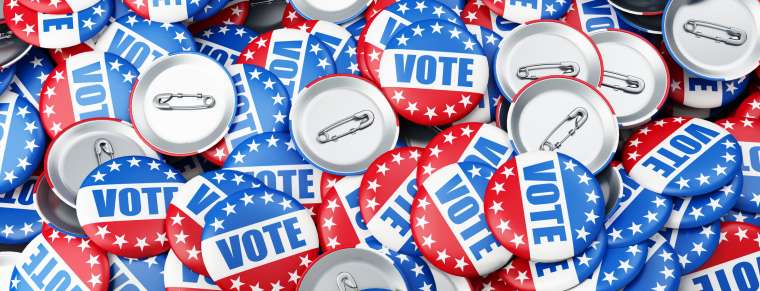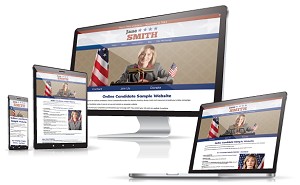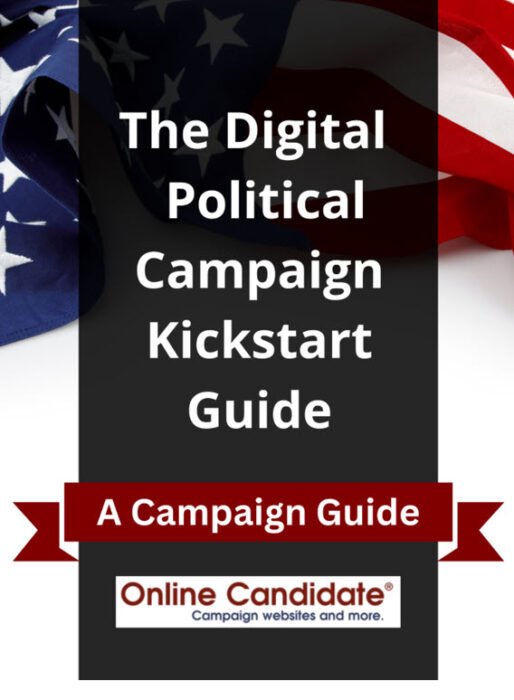Starting a political campaign, whether for federal, state, or local office, requires a clear strategy and disciplined execution. Every winning campaign starts with a roadmap, a plan that aligns your goals, message, and resources. You need to understand your values, the unique needs of your constituents, and how your leadership will address those needs.
Running for office also affects your personal and family life. Make sure you’ve discussed expectations and responsibilities with those closest to you before diving in. Once you’ve made that decision, it’s time to form a committee, recruit staff, and create a realistic campaign budget.
On top of that, you have to craft the right voter message and create an effective political campaign strategy to win.
It’s a lot, so let’s break it down.
Table of Contents
- Figure out why you are running
- Election preparation includes the basics
- Register as a candidate
- Launching your campaign – the right way
- As a politician, you must build a brand for yourself
- Building your digital presence
- Your online hub: The campaign website
- Set up your social media
- Launch your campaign with style
- Increase your chances of winning the election
- Final tips
Figure out why you are running
The first step in launching a political campaign is deciding what elected position you want to run for. It could be city council, school board, mayor, or another local role. Once you’ve made this decision, it will shape the direction of your campaign going forward.
The simple question, “Why are you running for office?” often stumps candidates. Your answer becomes the foundation of your campaign story. Be specific. Instead of “I want to improve education,” say, “I want to reducing class sizes in every school in the district.” That specificity builds voter trust.
Outlining your post-election goals and policies is also important. Voters will want to know how their interests will be served. Take the time to create a concise elevator pitch.
“Running for office is important, and you don’t really need more than to be right on the issues, and to be able to articulate what it is you believe. You don’t need a certain background. You don’t need to be a lawyer. You don’t need to have some professional degree.” – Matt Gonzalez
While you have your own motivations, you’ll need filter them through the political landscape you face. Learn the demographics of your constituency, current political trends, the major power players, and the important issues. Your strategy and messaging will be based on this analysis.
Example: A candidate in a small town in Iowa discovered that the largest voting bloc was under 40 but rarely turned out. Her campaign focused on town hall “happy hours” and early voting education, which helped boost turnout by 12%.
Election preparation includes the basics
Set concrete goals for your campaign: Short-term might include securing endorsements, while long-term goals could focus on policy changes you aim to implement once elected. Look at the total voter turnout data over the last few elections and how many people from each political party voted. Data and analytics are essential in modern political campaigns. By analyzing voter behavior and trends, you can be sure that your campaign decisions are evidence-based rather than going ‘with your gut.’
You may care about an issue, but if few other do, you’re not going to get much support.
So, what issues should you run on? It’s pretty simple, really. Take a stance, and campaign on the big issues that are important to your constituents and community. For example, in a suburban county, one candidate shifted her platform from national talking points to local issues like zoning and school safety after seeing polling data. That pivot resonated and carried her to victory.
A successful campaign is built on the backs of dedicated volunteers. Effective volunteer engagement involves more than just recruitment. It includes training, assigning suitable roles, and keeping them motivated. A well-organized volunteer force extends a campaign’s reach. It transforms grassroots energy into electoral success.
Find out how much money you’ll need to raise. Raising funds is a backbone of political campaigning. Develop a robust plan that includes political fundraising events, online campaign donations, and major donor solicitation.
One of the largest obstacles that political campaigns face is raising initial funds. Your plans, goals, and budget will determine when and how much you need to raise. A clear fundraising strategy, includes identifying potential donors, creating effective fundraising messages, and determining your fundraising channels. As your campaign goes on, you will need to adjust your strategy based on overall performance and donor feedback.
Put together your campaign team. Determine the specific tasks that need to be accomplished and find individuals with the skills and experience to effectively handle those tasks. Clear roles and responsibilities are important, and understanding each position’s duties ensures smooth operation. It enhances coordination and drives efficiency. When everyone on the team knows their role, the campaign operates at its best.
As you put your team in place, clearly communicate your plans and goals. Clear deadlines and expectations should be set for each team member. Get your people committed and put your plans to action.
“I don’t think running for office is anything I’m prepared for or could even prepare myself for.” – America Ferrera
Networking and relationships are important
Building and maintaining relationships is key in politics. Strong connections with community leaders, local influencers, and voters are invaluable. These relationships provide resources and support. Effective networking involves establishing and nurturing these connections both before and while you are running for office.
Many candidates leverage the advantages of coalition building. This means aligning with groups and organizations with similar values or goals as your organization. These other groups can help amplify your campaign’s reach and credibility through their own networks. To create a coalition, you’ll want to identifying potential allies and engage with them with the goal of forming partnerships that benefit both parties.
Register as a candidate
The registration process and requirements to get on the ballot differs between states. Most states have a registration deadline in order to get on the ballot.
Check with your secretary of state’s or county election website for information on filing requirements. There will be certain paperwork and fees you will need to pay. If there are signatures required, you will need to figure out how you will get them in time.
Understanding campaign law is crucial for political campaigns. It ensures all activities are legal and ethical. This includes finance regulations and electoral rules. Knowing your local campaign law helps avoids legal issues and problems on the campaign trail.
Launching your campaign – the right way
 Whether you are running a congressional campaign or want to begin a local political campaign for mayor or town council, you’ll want to prepare early.
Whether you are running a congressional campaign or want to begin a local political campaign for mayor or town council, you’ll want to prepare early.
Your campaign theme is the message used to communicate an integrated political message. It should be based on a clear reason why you are running, and backed up by an overall identity that shapes the overall campaign. This message should be short enough to not only tell a story, but can also be broken down for talking points that can be delivered to voters.
Your theme may be closely related to your campaign brand, which incorporates the look of your print material, signage and online presence.
As a politician, you must build a brand for yourself
Your campaign brand is the identity voters will come to recognize, trust, and remember. It should reflect your values, communicate your priorities, and stay consistent from the day you announce until Election Day.
Choose a color scheme, logo, and typography that fit the tone of your race and the community you’re running in. Use them across every asset — your local campaign website, yard signs, literature, social graphics, and donation pages. Consistency builds recognition, and recognition builds trust.
Think of your campaign as a brand with a promise. Voters should understand what you stand for within seconds of seeing your materials. Strong branding helps you communicate your vision before you say a single word.
Every piece of campaign material — brochures, palm cards, direct mail, digital ads, event signage, and social content — should align in design, tone, and message. When voters see your materials, they should immediately know they came from you.
Essential Photos to Prepare Early
- A Candidate Headshot
- Family Photos
- Informal Photos:
- Candidate with Audience Engagement
- Notable People and Endorsers
- Local Landmarks and Locations
Consider adding video to your branding toolkit. Even short, informal videos can help voters connect with you. Use them for your announcement, policy explainers, behind-the-scenes looks, or quick updates from events.
Once your branding is set, don’t change it. Shifting logos, colors, or slogans mid-race confuses voters and weakens recognition. We’ve seen candidates make mid-campaign brand changes, and it almost always causes more disruption than value.
Related Reading: The Power of Branding Your Political Campaign
Building your digital presence to expand your reach
Running a local political campaign is demanding. You’re competing for attention both offline and online, and voters increasingly form their first impressions from what they see on the internet. If you don’t define yourself digitally, someone else will — often your opponent.
A strong online presence helps you control your narrative, expand your reach, and meet voters where they already spend their time. Modern data and analytics tools also allow you to measure what’s working, adjust your messaging, and track engagement across platforms.
Your online hub: The campaign website
Your campaign website is the centerpiece of your online brand. It is the hub that ties together your print, social media, email marketing and digital advertising.
You want to be able to direct people to your campaign website to sign up to volunteer and make donations before, during, and after your political campaign launch.
The most important pages of a political website include:
- Homepage: Feature your identity and campaign goals; update as needed for developments and shifting focus.
- Biography: Condense your personal history into a concise bio that resonates with voters.
- Issues: Outline your positions and differentiate from your opponent; separate into distinct pages if needed.
- Endorsements: Include organizational endorsements and quotes across your site.
- News: Maintain a blog-style section for announcements, news links, and event coverage.
- Donation: Enable online donations and provide giving options.
- Volunteer: Gather volunteer information through an online form.
- Events: Display upcoming events in a list or calendar format.
A campaign site must be fast, mobile-optimized, and easy to navigate. Most voters will visit from their phones, often from a social or email link. Slow load times and cluttered layouts cost you donors and supporters.
Use basic SEO best practices so your site ranks for your name, the office you’re seeking, and your district. This helps ensure that voters searching for you find your materials first.
Set up your social media for success
For social media, you’ll want to create a Facebook page for the campaign. Other social platforms, like Twitter, Instagram, and Snapchat, can come later.
Tech Tip: Never use personal social media accounts for your political campaign. Facebook, in fact, does not allow for political campaigning on personal accounts.
If you began using social media early, you may already have an audience of supporters that you can communicate with. You can cross-post your content to multiple networks when possible to save time and reach more voters. Facebook, in particular, is a powerful platform to request donations and begin political advertising.
Many politicians use live streaming to interact with voters and non-voters. It’s not particularly difficult, and you don’t need a broadcast studio. In many cases, you can simply use your mobile phone to broadcast. Just short, informal updates from a phone feel more authentic than polished campaign videos.
Paid ads cut through the noise. Even a modest ad budget — $10–$25 per day — can grow awareness and drive donations.
Recommended Reading: How Much Should Your Political Campaign Budget For Digital?
Launch your campaign with style
The exciting task of officially launching your campaign calls for careful planning. Every aspect counts, from picking the ideal location to determining the ideal day and time to meet your target demographic.
Ideas for campaign launch events:
- Community Center Town Hall: Feature key local speakers, Q&A, and media presence.
- Park Rally: Combine food trucks, music, and speeches for a family-friendly kickoff.
- Virtual Launch: Use live streaming, polls, and social sharing to engage remote supporters.
- Neighborhood Walk: Go door-to-door or host a “walk and talk” with residents.
Organize a speaker lineup that raises interest in your campaign’s message. Press releases distributed to the local media can generate interest and raise awareness.
Increase your chances of winning the election
Launch day for your online campaign is always exciting. Put together a checklist to cover all your action items. To increase the chance of everything going smoothly, you’ll want to have the following in place:
- Your campaign website, which should be easy to navigate and include clear calls to action,
- Social media accounts, along with their graphics.
- A campaign Google account for analytics, email, and more.
- Broadcast email system, including signup forms on the site.
- A plan to advertise, and perhaps a digital budget earmarked to make it so.
Creating and distributing campaign material is another essential way to reach the electorate. When developing a content strategy, you should do the following:
- Identify your target voters: Learn the key demographics and interests of your audience. Create content that directly speaks to them.
- Clearly define your message. Clearly articulate and repeat your political message over and over. In other words, always “stay on message.”
- Create online content that engages: Go beyond text and images with your content. Use videos, infographics, press releases, and social content to keep your audience engaged.
- Use a content calendar. Plan out your content in advance and schedule material for specific times, such as primary and Election days. Also, plan out how you will promote campaign events and fundraising initiatives.
- Develop and use marketing channels. Social media is fine, but also consider mobile outreach and email to engage a wider audience.
Final tips
Many candidates keep their campaign websites on a ‘coming soon’ page right until the campaign launch day. Then they wonder why their site does not immediately show up in search results. Search engines take time to index websites. Just because your site goes live does not mean that it will be indexed right away or at all. One way to trigger search engine spiders is to link to your site from another source, such as a Facebook or Twitter account.
Launch your campaign website ahead of your announcement to ensure search engines have indexed it. This makes it easier for voters to find you right from the start. Besides, no one will likely be searching for it anyway. And if they do find your site, does it really matter? That’s not to say that your launch announcement should not be heavily promoted. You will need that initial excitement to capitalize on your initial fundraising and outreach efforts.
Getting into politics is a big decision. Even if you are running for local government, you need to lay a proper foundation and prepare to announce your candidacy.
Download the Free Checklist: Pre-Campaign Planning Checklist [PDF]
Sign up below for campaigning tips and strategies. Online Candidate also provides a variety of political web design and marketing services.
Image courtesy of FreeDigitalPhotos.net
« Winning Local Elections Is About Getting Voters To Take ActionHow Much Should Your Political Campaign Budget For Digital? »
Tags: seed money








